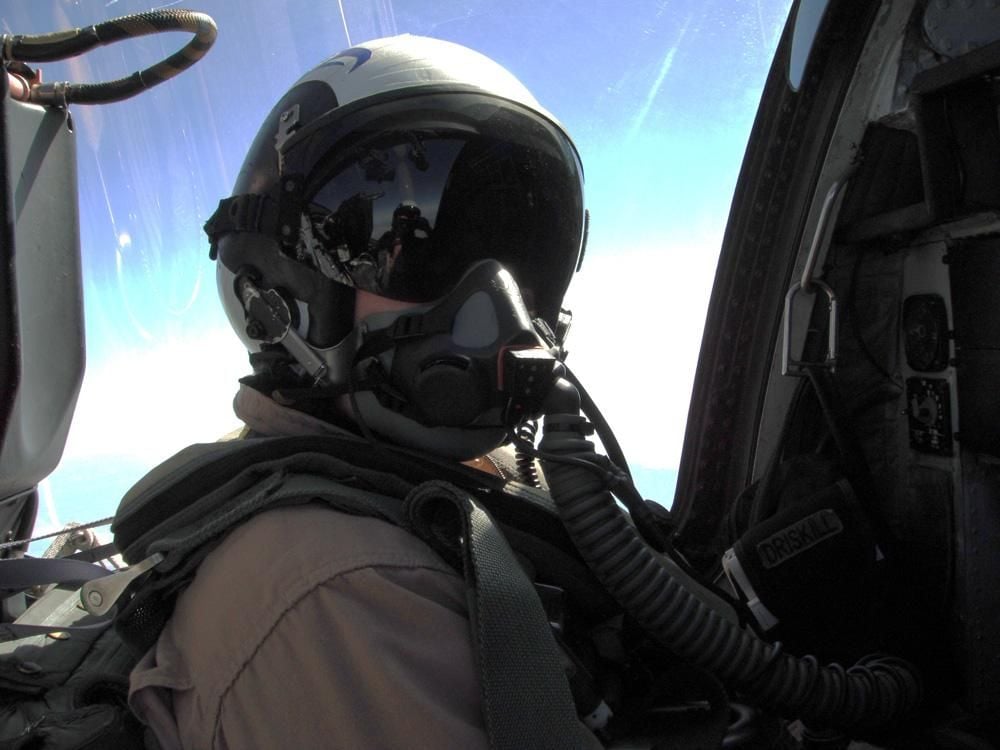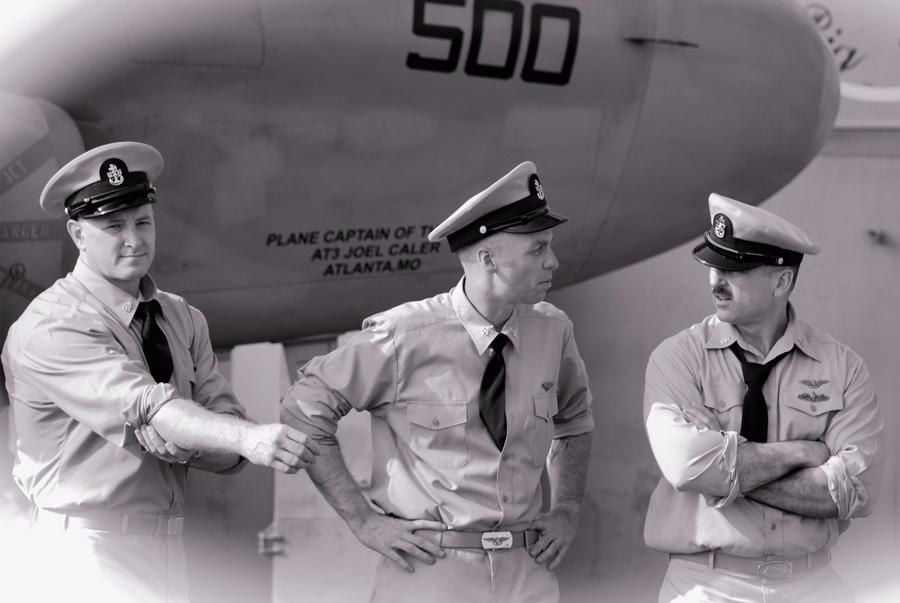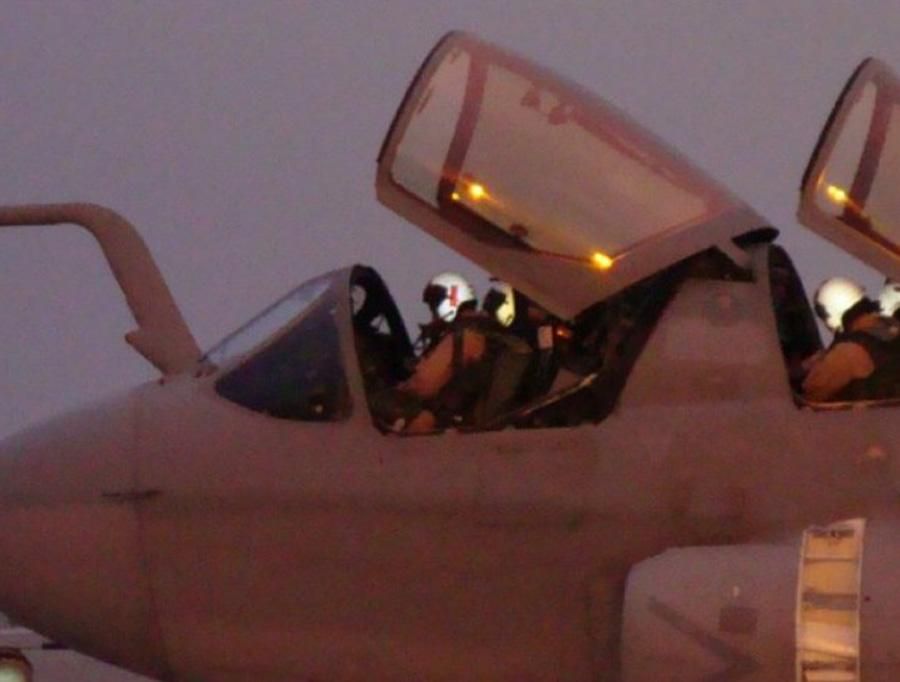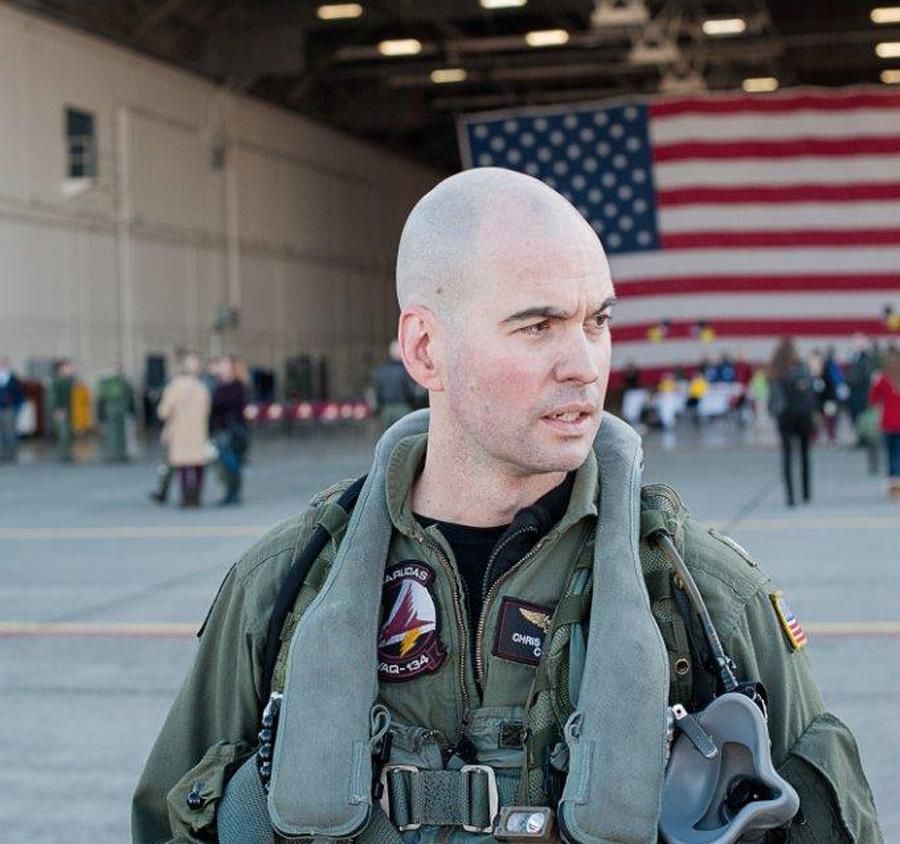Saying Goodbye to the Prowler
To mark its retirement, some recollections from the people who knew the EA-6B best.
![Iraq Dust Storm[2].jpg](https://th-thumbnailer.cdn-si-edu.com/PNZM_wF8NXdAWLqZGiwNSVTU_Zg=/1000x750/filters:no_upscale()/https://tf-cmsv2-smithsonianmag-media.s3.amazonaws.com/filer/c7/2c/c72c4b8d-6981-4cd4-9861-8ca8bb634979/iraq_dust_storm2.jpg)
It was the first aircraft built specifically for electronic warfare, and for 48 years, the Northrop Grumman EA-6B Prowler quietly went about its business jamming enemy radar and communications and gathering intelligence. The U.S. Navy retired its last Prowler in 2015; the Marine Corps in March of this year.
We didn’t want to let this unsung hero head into retirement without a few final stories from some of the aircrews and ground crews who helped support the Prowler’s mission.
Lieutenant Colonel Dean Driskill | Electronic Countermeasures Officer, U.S. Marine Corps (ret.)
An ECMO with 2,340 hours in the EA-6B, Driskill served in the Marine Corps from 1997 to 2017.

All my life I knew I wanted to follow in my dad’s footsteps and fly for the Marine Corps, and my dream was to fly with the Prowler. As an Electronic Countermeasures Officer, or ECMO, one of my principle jobs was not only to do the primary electronic warfare mission, but also to be an active copilot and navigator.
When people think of electronic warfare, they rightly think of radar jamming. The measure of our success was never really how big an explosion we caused ourselves, but how many people got back safely. That particular aspect was something that was near-and-dear to Prowler aircrew and to the ground crews that worked the hours to get the aircraft up in the air.
Here’s an unclassified example of that. We were within the first couple of weeks of Operation Iraqi Freedom, the big drive up from Kuwait into Baghdad [in 2003] to liberate the Iraqi people. The Marines on the ground were progressing a little faster than military planners had originally predicted. We were still in a very hostile situation and the Iraqis were putting up a stout defense. There was one situation where we were on station supporting the Marines on the ground, and we got a call from one of the Forward Air Controllers, or FACs, and he asked us if we could provide some communications jamming on a specific radio frequency. We started jamming that frequency, but we told him that we were a little bit low on fuel, and we were scheduled to go to our air-to-air tanker in just a couple of minutes. However, we could tell just by his voice inflection that things on the ground were hectic and dangerous. He kept pleading and imploring us, “You have to stay on station and continue to jam these communication frequencies.” We could tell by his voice that something serious was going on, so we continued to jam, we continued to deny the Iraqis those frequencies. We told him again that we were getting really low on gas and he told us he still had to have us stay on a little bit longer. So we did.
We got to an extremely low fuel state when we finally told him that we had to go. He said, “Ok, roger,” and we were released at that point. We didn’t find out until we landed that because the Marines had been advancing so quickly, the artillery [units] had actually gotten out of synch. Historically, one Marine artillery unit will be in place and provide artillery cover and the next artillery unit will essentially leapfrog forward and get in the new position. Well, they were advancing so quickly that both the artillery units were moving forward at the same time. As a result, there was no artillery support for this period of time.
We didn’t know until we actually landed, but the Iraqis were using this specific radio frequency to try and coordinate firing their artillery onto the Marines that were advancing in combat. The only thing that kept them from firing was us jamming the Iraqi communications frequency. So that was kind of a goose-bump moment.
In fact, when we landed, the two-star general who was running the air war out of the Combined Air Operations Center called us and thanked us personally and immensely, because of the fact that we did unequivocally save a whole bunch of Marine Corps infantry lives.
That was just one example of how a Prowler with its electronic warfare capabilities and its jamming capabilities provided direct tangible results. The Prowlers were quite often the unsung heroes. And that was fine with us. Our job was to help other aircraft and ground forces do their job.
Master Chief Avionics Technician Jon Walsh | U.S. Navy, 1991-present
In addition to the Prowler, Walsh has maintained the Grumman A-6 Intruder and the Boeing EA-18G Growler.

I’ve done 14 deployments, five of them with Prowlers. I was in one of the last A-6 squadrons, and when we went from the A-6 to the Prowler, the engineers extended the nose of the airplane out a couple of feet and put in another two seats. It went from bombing systems to electronic warfare systems. That added about 4,000 pounds of extra wiring to the airplane. It’s several hundred miles of wiring, or more.
When we’d get a gripe from an aircrew, we’d start our search with the block diagrams and the wiring diagrams, and then narrow it down. Instead of it being thousands and thousands of wires to troubleshoot, that might break it down to 50 wires you’ve got to worry about. Also, the aircraft go through modifications during different parts of their lives, and not all the aircraft will get the exact same modification. So, electrically-speaking, every aircraft is a little bit different even though they’re all supposed to be exactly the same.
We’d have various scheduled inspections; for example, there’s a 28-day or 56-day corrosion inspection, where we’d take a certain number of panels off and look for corrosion and dirt and then clean the aircraft and do preventative stuff, and then put the panels back on. On the aircraft carrier you get a lot of salt spray, so the corrosion inspection is a lot more important than when you’re on land.
If you’re taking panels off the jet and putting them back on, and you took a critical-length screw that was supposed to be in one area of the panel and you put it on a different area of the panel, the screw can go through the wiring, and that can induce problems too. It was a hard airplane to troubleshoot and work on; you had to be pretty good at troubleshooting.
I now work on the Growler, and there are similarities between the two aircraft. The AN/ALQ-99 transmitter pods are the exact same assets that the F-111 used; so we’re using the same technology in three different platforms. The Prowler was fun to work on, and it’s kind of sad to see it leave because you’re not going to get the same caliber of troubleshooters out of the Super Hornet that you did with the Prowler. You really had to know your stuff to be able to fix it.
Lieutenant Colonel Todd Gates | Electronic Countermeasures Officer and EA-6B Pilot, U.S. Marine Corps (ret.)
Gates accrued 1,500 hours as an ECMO in the Prowler before transferring to the pilot’s seat, where he earned another 1,400 hours.

I was an ECMO before I was a pilot, so I’ve done all four seats in the EA-6B. I spent almost four years as an ECMO before I got picked up for the pilot transition. I loved flying the airplane. The people that I flew with in the EA-6B are the reason why I wanted to come back to the Prowler after flight training.
What I really enjoyed about the EA-6B is that you get a wide range of personalities in the Prowler squadron. You get everybody from the “nerd” to the super cocky guy, plus everybody in between. The people are really what make our community great—and not just the people who flew the aircraft; it’s also the people who fixed it and maintained it. It’s an awesome community, and I’m really proud to be a part of it.
In 2003, I was an ECMO with VMAQ-2 [Marine Tactical Electronic Warfare Squadron 2], and we were based out of Prince Sultan Airbase in Saudi Arabia, about an hour south of the border with Iraq and Saudi Arabia. We flew five to six times a week escorting strike packages into Baghdad. On this particular day in March 2003, my combat crew was made up of the pilot, Captain Charles “Dutch” Roell; myself; and Captain David “Mayor” Manka. Our commanding officer was Lt. Col. James “Doc” Docherty.
We had escorted a couple of strike packages already, and coming off the target we had some faulty engine indications and some high oil pressure. We all decided very quickly that we needed to shut down the engine before it came apart and took out the other engine, which would turn us into a glider, not an airplane.
The decision to shut down the engine was made very fast, probably less than 5 to 7 seconds. But what we had left was one engine, and we were in Iraq. The concern was that although the Iraqi military at the time was not really shooting guided missile shots, they were still shooting missiles ballistically up in the air, and we feared that we didn’t have enough kinetic energy, or enough engine power, in lay terms, to be able to maneuver, to not get shot and get blown to smithereens. On one engine the airplane basically has enough energy to keep it flying and that’s about it. If we wanted to maneuver, it just wasn’t going to happen; you’d stall the airplane.
It was very quiet after we shut the engine down. Obviously, we started out with a very high rate of speed, and that speed bleeds off. The first question that broke the silence was our skipper who asked us, “Do you want to try and land at a divert airfield?” We were northwest of Talil Airbase, heading back to the border of Saudi and Iraq. Our skipper said, “I heard they have Harriers land there.” Harriers don’t have the same runway requirement that we do, and we didn’t know the status of the airfield. Are the Iraqis still there, or is it just one section of the airfield where they were able to land or take off? We didn’t have any intelligence on what the status of that airfield was. But it was a consideration as a possible airfield.
The nearest friendly airfield was Al Jabar in Kuwait, which had a huge maintenance depot, security, food, water, the whole nine yards. But it was an hour and 45 minutes away to the southeast. Were we even going to make it that far? What happens if the other engine quits? We talked about landing in Talil Airbase in Iraq, and the pros and cons of landing there, versus going back to Kuwait. My skipper easily could have said, “This is what we’re doing.” But, being the fantastic leader that he is, he said, “Listen. We’re going to take a vote. And if it’s two to two, I’ll tie break, my vote will count twice, because I’m the commanding officer. But let’s take a vote.” We all voted, we were all on the same page, four to zero, to take it back to Al Jabar, Kuwait.
With a single engine you have to fly at a lower altitude. After we lost the engine, I think we ended up at about 18,000 or 19,000 feet; we lost 8 or 9,000 feet of altitude. So now we’re having to fly lower, and we’re having to fly slower, which exposes us to bad guy territory for a longer time. All not good things.
There was a lot of thunderstorm activity that night as well. We broadcasted over our ATC [air traffic control] frequency that we’re an emergency aircraft, and we’re heading to Al Jabar Kuwait. No less than three or four aircraft, other Marine aircraft, rolled up behind us, and used their radar to give us headings like, “You need to come left a little bit to get around this thunderstorm activity.”
The years of training we receive—both leadership training as Marines, aviation training as Marines, and as Naval aviators—got the airplane home and safe, and turned what could have been a very bad situation into a happy ending.
Captain Chris Jason | Electronic Countermeasures Officer, U.S. Navy
Jason has 2,726.4 hours as an ECMO. He recently assumed command of Naval Air Station Corpus Christi.

In 2009 I was the Tactics Officer for VAQ-134 (the Garudas), deployed to Bagram Airfield, Afghanistan. Part of my duties included serving as liaison with the Army, Marine Corps, and Air Force units we supported, to include training their electronic warfare liaison officers as their units arrived to theater. Each month I hosted 12-20 such officers and senior enlisted and taught them the basics of what our aircraft could do for them and what we needed from each other to coordinate effectively. All of this paid huge dividends, and we heard amazing feedback from our supported units on the difference we made—the lives we saved. It was an incredibly rewarding deployment, and I remember fondly how tight the squadron was, across all ranks, due to the shared dangers of living on Bagram.
The Prowler humbly and unassumingly saved lives for decades, behind the scenes and with little fanfare. In a way, the aircraft was a victim of its own success, as it was easy to underestimate the enemy threat when it was so successfully neutralized. But despite this and the fact that the art of electronic warfare is not well understood outside of the EW community, the broader defense community learned to appreciate this amazing machine. Time and time again we saw that when the Prowler was not there, bad things happened. When it was on station, forces were protected. It’s not just the effort of the aircrew that delivered that result, it was the effort of the maintainers who got that aircraft flying, and the engineers and scientists behind the constantly evolving, sophisticated equipment. A huge group of folks put a great deal of effort into this aircraft being on station and delivering its capabilities, and many service members are alive today because of it.
In 2015 I flew on the Prowler’s last carrier-arrested landing. I was in the front right seat as ECMO 1, and Lieutenant Winston “Favre” Likert was the pilot. It was a night landing on the USS George H.W. Bush, the last landing our squadron needed to complete a readiness refresher. Typically, during carrier landing practice at the field, the last ball call [ball refers to the optical landing system] is made with the word “final” on the radio, so that the landing signal officer grading you knows this is your last pass. This is done during field practice only, and not at the ship, but since this was going to be the Prowler’s final trap ever, I asked Favre if he was comfortable with me adding “final” to the ball call. That was a lot of pressure on him, because if he missed the wires, it would be quite embarrassing to have to call “final” twice, but he said “let’s do it” and so we did: “502, Prowler Ball, 8.0, final.” Apparently our Strike Group Admiral was listening, and thought the “final” call was pretty gutsy. After the successful trap, we taxied to the catapult and launched off for Norfolk to complete not only our detachment, but the Prowler’s aircraft carrier career. It’s a history that I am truly honored to have been a part of.